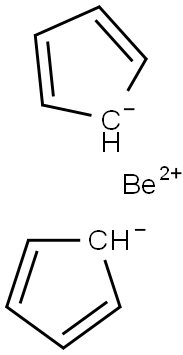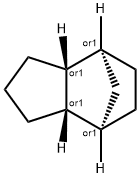Ferrocene
Synonym(s):Bis(cyclopentadienyl)iron;Di(cyclopentadienyl)iron;Dicyclopentadienyliron, Iron dicyclopentadienyl;Ferrocene
- CAS NO.:102-54-5
- Empirical Formula: C10H10Fe
- Molecular Weight: 186.03
- MDL number: MFCD00001427
- EINECS: 203-039-3
- SAFETY DATA SHEET (SDS)
- Update Date: 2025-09-25 17:15:13

What is Ferrocene?
Description
The synthesis of ferrocene, an organometallic iron complex, has become a very popular experiment for inorganic laboratory courses.
Description
Ferrocene, a metallocene, is a bright orangesalt-like crystals from alcohol with a camphor odor.Molecular weight = 186.05; Boiling point = 249 C (sublimes); Freezing/Melting point = 173 C. Decomposes at465 C. Hazard Identification (based on NFPA-704 MRating System): Health 2, Flammability 2, Reactivity 1.Insoluble in water.
Chemical properties
Orange, crystalline solid; camphor-like odor. Insoluble in water; soluble in benzene, ether, and alcohol. Iron content 29.4–30.6%.
Chemical properties
Ferrocene, a metallocene, is a bright orange salt-like crystals from alcohol. Camphor odor.
Physical properties
Orange crystals; camphor-like odor; melts at 172.5°C; vaporizes at 249°C; sublimes above 100°C; thermally stable above 500°C; insoluble in water; soluble in alcohol, ether and benzene; also soluble in dilute nitric acid and concentrated sulfuric acid forming a deep red solution that fluoresces.
The Uses of Ferrocene
Ferrocene is used as a catalyst for vulcanization, acceleration, and polymerization, as a chemical intermediate for polymeric compounds such as high temperature polymers, as an antiknock additive for gasoline, as a coating for missiles and satellites, and as a high-temperature lubricant.
The Uses of Ferrocene
Antiknock additive for gasoline; catalyst.
The Uses of Ferrocene
In ultraviolet stabilizers and smoke depressants for polymers; to increase the burn rate of rocket propellants; to prevent erosion of space capsule shields; to improve the viscosity of lubricants; to catalyze polymerization reactions; to catalyze combustion; some derivatives used as hematinic agents
What are the applications of Application
Ferrocene is a source of ferrocene derivatives; the derived ferrocenium salts find use as mild oxidants
Definition
A coordination compound of ferrous iron and two molecules of cyclopentadiene in which the organic portions have typically aromatic chemical properties. Its activity is intermediate between phenol and anisole. The first compound shown to have the “sandwich
Definition
ferrocene: An orange-red crystallinesolid, Fe(C5H5)2; m.p. 173°C. Itcan be made by adding the ioniccompound Na+C5H5- (cyclopentadienylsodium, made from sodium andcyclopentadiene) to iron(III) chloride.In ferrocene, the two rings are parallel,with the iron ion sandwiched betweenthem (hence the namesandwich compound: see formula).The bonding is between pi orbitalson the rings and d-orbitals on theFe2+ ion. The compound can undergoelectrophilic substitution on theC5H5rings (they have some aromatic character).It can also be oxidized to theblue ion (C5H5)2Fe+. Ferrocene is the first of a class of similar complexescalled sandwich compounds. Its systematicname is di-π-cyclopentadienyliron(II).
Production Methods
Ferrocene is produced from the reaction of cyclopentadiene with reduced iron in the presence of metal oxides. There is also a two-stage production process in which produced iron (II)oxide (stage 1) is reacted with cyclopentadiene.
Preparation
Dicyclopentadienyliron may be obtained in a single-step synthetic route by heating cyclopentadiene with iron or iron pentacarbonyl at 300°C:
2C5H5 + Fe → (C5H5)2Fe
Also, it can be prepared by the reaction of iron(II) chloride with cyclopentadiene in the presence of an alkyl amine or a similar base.
Another convenient method of preparing this π-complex of iron is a twostep process in which the first step involves preparation of cyclopentadienyl Grignard reagent, such as 2,4-cyclopentadienylmagnesium bromide C5H5MgBr which may then be combined with ferric chloride to yield dicyclopentadienyl iron:
3C5H5MgBr + FeCl3 → (C5H5)2Fe + 3MgBrCl
Another general method of preparation involves the reaction of cyclopentadiene with sodium metal or sodium hydride in tetrahydrofuran (THF). Addition of iron(II) chloride to this solution forms the complex dicyclopentadienyliron:
2C5H6 + 2Na → 2C5H5ˉ + 2Na+ + H2
In 3:2 molar ratio of cyclopentadiene to sodium cyclopentene is obtained along with cyclopentadienidide (C5H5ˉ ) anion:
3C5H6 + 2Na → 2C5H5¯ + 2Na+ + C5H8
FeCl2 + 2C5H6Na → (C5H5)2Fe + 2NaCl
General Description
Orange crystalline solid or orange-yellow powder. Sublimes above 212°F. Camphor odor.
Air & Water Reactions
Sensitive to prolonged exposure to air and may be sensitive to light. Insoluble in water.
Reactivity Profile
Ferrocene reacts violently with tetranitromethane. . Contact of tetranitromethane with Ferrocene under various conditions leads to violent explosion, [Trans. Met. Chem., 1979, 4, 207-208].
Hazard
Moderate fire risk. Evolves toxic products on decomposition and heating.
Health Hazard
Dicyclopentadienyl iron causes
changes in blood parameters and hepatic
cirrhosis.
The toxicological properties of dicyclopentadienyl
iron have not been extensively
investigated. However, it has been used as a
preventive and therapeutic iron deficiency
drug, and its utilization is listed as tolerable.
Fire Hazard
Flash point data for Ferrocene are not available. Ferrocene is probably combustible.
Flammability and Explosibility
Highly flammable
Safety Profile
Poison by intraperitoneal and intravenous routes. Moderately toxic by ingestion. Questionable carcinogen with experimental tumorigenic data. Mutation data reported. Flammable; reacts violently with NH4ClO4. When heated to decomposition it emits acrid smoke and irritating fumes.
Potential Exposure
Used as additive in fuel oil; antiknock agent in gasoline fuel; used in making rubber, silicone resins, high-temperature polymers and lubricants; interme diate for high-temperature polymers; as a smoke suppres sant and catalyst
First aid
If this chemical gets into the eyes, remove anycontact lenses at once and irrigate immediately for at least15 min, occasionally lifting upper and lower lids. Seek medical attention immediately. If this chemical contacts theskin, remove contaminated clothing and wash immediatelywith soap and water. Seek medical attention immediately. Ifthis chemical has been inhaled, remove from exposure,begin rescue breathing (using universal precautions, including resuscitation mask) if breathing has stopped and CPR ifheart action has stopped. Transfer promptly to a medicalfacility. When this chemical has been swallowed, get medical attention. Give large quantities of water and inducevomiting. Do not make an unconscious person vomit.
Carcinogenicity
Ferrocene was administered by intramuscular injection at a dose of 5175 mg/kg/2 years. By the criterion established by the Registry of Toxic Effects of Chemical Substances (RTECS), ferrocene was an equivocal tumorigenic agent and tumors were most evident at the site of multiple injections.
Storage
Color Code—Red: Flammability Hazard: Store ina flammable materials storage area. Prior to working withthis chemical you should be trained on its proper handlingand storage. Store in tightly closed containers in a cool,well-ventilated area away from oxidizers, ammonium perchlorate, tetranitromethane, mercury(II) nitrate, and heat.Sources of ignition, such as smoking and open flames, areprohibited where this chemical is used, handled, or stored ina manner that could create a potential fire or explosionhazard.
Shipping
UN1325 Flammable solids, organic, n.o.s., Hazard Class: 4.1; Labels: 4.1-Flammable solid.
Purification Methods
Purify it by crystallisation from pentane or cyclohexane (also *C6H6 or MeOH can be used). It is moderately soluble in Et2O and sublimes readily above 100o. Crystallisation from EtOH gave material m 172.5-173o. [Wilkinson Org Synth Coll Vol IV 473 1963, Miller J Chem Soc 632 1952.] It has also been crystallised from methanol and sublimed in vacuo. [Saltiel et al. J Am Chem Soc 109 1209 1987, Beilstein 16 IV 1783.]
Structure and conformation
X-ray diffraction studies show that in crystalline ferrocene (and in its
substituted derivatives) the iron atom is "sandwiched" between the two cyclopentadienyl
rings, these rings having the staggered configuration relative to each other (Fig. 16). The
rings are parallel plane regular pentagons, all the C-C and Fe-C distances being equal.
Electron diffraction studies show, however, that ferrocene has the eclipsed configuration
in the vapour state.
Incompatibilities
Violent reaction with ammonium per chlorate, tetranitromethane, mercury(II) nitrate. Incompa tible with oxidizers (chlorates, nitrates, peroxides, perman ganates, perchlorates, chlorine, bromine, fluorine, etc.);
contact may cause fires or explosions. Keep away from
alkaline materials, strong bases, strong acids, oxoacids,
epoxides.
Peroxomonosulfuric acid. Decomposes @≧465 ℃.
Properties of Ferrocene
| Melting point: | 172-174 °C (lit.) |
| Boiling point: | 249 °C (lit.) |
| Density | 1.490 |
| vapor pressure | 0.03 mm Hg ( 40 °C) |
| Flash point: | 100°C |
| storage temp. | Store below +30°C. |
| solubility | insoluble in H2O; soluble in ethanol, ethyl ether,benzene, dilute HNO
3 |
| form | crystal |
| color | orange |
| Water Solubility | practically insoluble |
| Sensitive | Air & Moisture Sensitive |
| Merck | 14,4037 |
| Sublimation | 100 ºC |
| Exposure limits | ACGIH: TWA 10 mg/m3; TWA 1 mg/m3 OSHA: TWA 15 mg/m3; TWA 5 mg/m3 NIOSH: TWA 10 mg/m3; TWA 5 mg/m3; TWA 1 mg/m3 |
| Stability: | Stable at room temperature. Incompatible with strong oxidizing agents. Highly flammable. |
| CAS DataBase Reference | 102-54-5(CAS DataBase Reference) |
| NIST Chemistry Reference | Ferrocene(102-54-5) |
| EPA Substance Registry System | Ferrocene (102-54-5) |
Safety information for Ferrocene
| Signal word | Danger |
| Pictogram(s) |
 Flame Flammables GHS02  Exclamation Mark Irritant GHS07  Health Hazard GHS08  Environment GHS09 |
| GHS Hazard Statements |
H228:Flammable solids H373:Specific target organ toxicity, repeated exposure H410:Hazardous to the aquatic environment, long-term hazard |
| Precautionary Statement Codes |
P202:Do not handle until all safety precautions have been read and understood. P210:Keep away from heat/sparks/open flames/hot surfaces. — No smoking. P273:Avoid release to the environment. P301+P312:IF SWALLOWED: call a POISON CENTER or doctor/physician IF you feel unwell. P308+P313:IF exposed or concerned: Get medical advice/attention. |
Computed Descriptors for Ferrocene
Ferrocene manufacturer
CEFA CILINAS BIOTICS PVT LTD
New Products
4,4-Difluoropiperidine hydrochloride tert-butyl 9-methoxy-3-azaspiro[5.5]undecane-3-carboxylate Indole Methyl Resin N-Isopropylurea N,N-Dicyclohexylcarbodiimide(DCC) MELDRUMS ACID 5-METHYLISOXAZOLE-4-CARBOXYLIC ACID Magnessium Bis glycinate Zinc ascorbate 1-bromo-2-butyne 2-acetamidophenol 9(10H)-anthracenone Erythrosin B, 4-Piperidinopiperidine 2-((4-morpholinophenylamino) (methylthio) methylene) malononitrile 2,4-dihydroxybenzaldehyde 3-(4-morpholinophenylamino)-5-amino-1H-pyrazole-4-carbonitrile Methyl 2-methylquinoline-6-carboxylate 2,6-dichloro-4-nitropyridine 4-Bromo-2-chlorobenzonitrile 2-(benzylamino)acetic acid hydrochloride 4-(tert-Butoxycarbonylamino)but- 2-ynoic acid 3,4-dihydro-2H-benzo[b][1,4]dioxepine 1-Phenyl-1-cycloprppanecarboxylicacidRelated products of tetrahydrofuran








You may like
-
 Ferrocene CAS 102-54-5View Details
Ferrocene CAS 102-54-5View Details
102-54-5 -
 Ferrocene 95% CAS 102-54-5View Details
Ferrocene 95% CAS 102-54-5View Details
102-54-5 -
 Ferrocene CAS 102-54-5View Details
Ferrocene CAS 102-54-5View Details
102-54-5 -
 Ferrocene Cas 102 54 5View Details
Ferrocene Cas 102 54 5View Details
102-54-5 -
 25 kg Ferrocene 99% (CAS NO:102-54-5)View Details
25 kg Ferrocene 99% (CAS NO:102-54-5)View Details
102-54-5 -
 FerroceneView Details
FerroceneView Details
102-54-5 -
 Ferrocene Cas 102 54 5View Details
Ferrocene Cas 102 54 5View Details
102-54-5 -
 50 kg Ferrocene Cas 102 54 5, PowderView Details
50 kg Ferrocene Cas 102 54 5, PowderView Details
102-54-5
